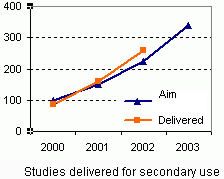Use of FSD services on the increase
Mari Kleemola 28.2.2003
In 2002 FSD continued to establish itself. There were clear indicators that the use of FSD services was on the increase and the archive was becoming better known, even though the number of studies deposited with the archive was somewhat smaller than anticipated.
Busy year for user services
78 data sets were deposited with the archive in 2002, which was somewhat less than the anticipated 100. Data sets arrived in various formats, for example, in SPSS, SAS, ASCII and Excel.
 259 studies were ordered for secondary use. The archive aimed at 50 per cent increase compared to the previous year and this was easily reached. Figure 1 shows the anticipated and actual figures for the years 2000-2003. Taking into consideration the number of deposited studies, the number of delivered studies was particularly delightful. The figures indicate that the archive is becoming better known and that a new kind of thinking has established itself in the Finnish scientific community. 259 studies were ordered for secondary use. The archive aimed at 50 per cent increase compared to the previous year and this was easily reached. Figure 1 shows the anticipated and actual figures for the years 2000-2003. Taking into consideration the number of deposited studies, the number of delivered studies was particularly delightful. The figures indicate that the archive is becoming better known and that a new kind of thinking has established itself in the Finnish scientific community.
In 2002 about 12 per cent of data delivered by the FSD were used for methodology teaching courses and 20 per cent for master's and other type of theses. The rest (68 %) were used as source material or comparative material for dissertations or other research. The number of delivered studies is higher than the number of access applications and persons receiving studies because applicants often order more than one study with one access application. On the other hand, both in research and especially in teaching each delivered study is in fact used by several researchers or students.
FSD's information services have a wider task that simply technically deliver studies and their documentation. FSD receives numerous information enquiries connected to secondary use of data. The enquiries are answered but only a part of them lead to the actual use of data.
On the whole people from ten Finnish universities have used FSD services. Most users were connected with the universities of Turku, Helsinki or Tampere. About ten percent of data applications came from abroad.
Use of FSD web pages doubled
Charting deposited or delivered data describes only a part of the archive's activities. A major part of the services are available on FSD's open web pages. The use of FSD user services can be roughly estimated by looking at the use of our web pages. But no statistics can tell whether a study has not been done or a question of a survey left out after getting acquainted with FSD material.
In 2002, internal use and search engines excluded, the use of web pages was considerably more frequent than in 2001. At best there were 30 000 web requests a month which was twice as many as in the busiest month of 2001. Research Methods Web Resource (MOTV) was the most popular. In 2002 at least twenty methodology courses in different universities used MOTV.
Top of page | Privacy Policy
|